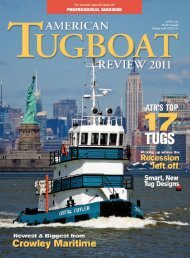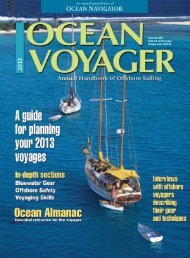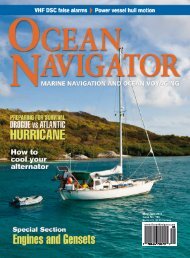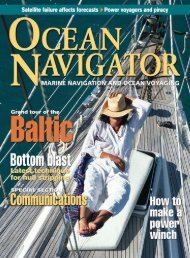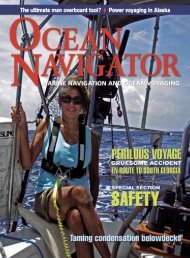October 2011 Issue No. 197 - Navigator Publishing
October 2011 Issue No. 197 - Navigator Publishing
October 2011 Issue No. 197 - Navigator Publishing
Create successful ePaper yourself
Turn your PDF publications into a flip-book with our unique Google optimized e-Paper software.
Nav ProblemCarleton Mitchell and FinisterreCarletonMitchell’s yawlFinisterre, wasdesigned byOlin Stephens.From Isles of the CaribbeesCarleton Mitchell, whodied in 2007 at the ageof 96, was perhaps the mostinfluential of the post-wargeneration of offshore cruisersand racers who created the“cruising lifestyle.” Combininghis skill as a photographer andwriter, Mitchell, in more thanseven books, wrote about thebest of the cruising life in theCaribbean and the Bahamas.When he first went to theWest Indies in 1947 therewere empty anchorages andno tourists. Mitchell, for betteror worse, helped make theCaribbean Islands the destinationthey are now.During Word War IIMitchell taught combatphotography in the U.S.Navy. After the war hepurchased an old Aldendesign Malabar thathe named Carib. Hetook off to the WestIndies and wrote hisfirst book, Islands toWindward in 1948.He then sold Cariband purchased a58-foot Rhodesyawl, he calledCaribee, winninga trans-Atlanticrace toEngland thathe chronicled in PassageEast in 1953. He wrote thecredo of all sailors: “To desirenothing beyond what you haveis surely happiness. Aboard aboat, it is frequently possible toachieve just that.”Mitchell desired a roomyboat small enough for a coupleto handle, beamy enough tobe comfortable and to hold allhis gadgets, shallow enough togunkhole in the Bahamas, yetstrong enough for an oceanpassage. And fast. He took thisbrief to Olin Stephens andthey came up with Finisterre.Finisterre was 22,000pounds with an 11-foot3-inch beam and a waterlineof 27 feet 6 inches.Finisterre was built withConnecticut white oakframes, African mahoganyand teak for the interiors.The hull was double-plankedHonduras mahogany overPort Orford cedar.Finisterre was everythingthat Mitchell hoped for. Underhis stewardship, Finisterre wonthree consecutive Bermudaraces in 1956, ’58, and ’60. Itwas often said that the boatwas a rule beater and that mayhave helped her win the firstBermuda race. But by 1958,other boats were copying thestyle, yet Mitchell’s skill still ledhim to victory.Let’s join Mitchell andhis merry band on the wayBY DAVID BERSONto Bermuda. It is June andMitchell is on deck contemplatinga noon sight. Finisterreis bowling along under spinnakerand mizzen staysail. Thebreeze is fresh and everyone ishappy and the sea sparkles. Itis June 23 (we’ll use the <strong>2011</strong>Nautical Almanac), and theDR of Finisterre is 36° 10’ Nby 67° 35’ W. The height ofeye is eight feet and there is nosextant error or watch error.The Hs of the lower limb is76° 37.8’ The boat is east ofthe rhumb line and movingfast with a northerly pushingthem along.A. What is the time in GMTfor LAN?B. What is the Ho?C. What is the latitude? Whatdoes this shot tell him abouthis sun line versus his DR?For a complete solution,visit www.Ocean<strong>Navigator</strong>.com.AnswersA. Time of LAN in GMT is16:32:20B. Ho is 76° 50.7’C. Latitude is 36° 35’ NThe shot tells Mitchell thatFinisterre is going faster thanhis taffrail log says. This canhappen in the Sargasso Seawhere the log gets fouledwith weed and slows down.56 OCEAN NAVIGATOR OCTOBER <strong>2011</strong> www.oceannavigator.com




